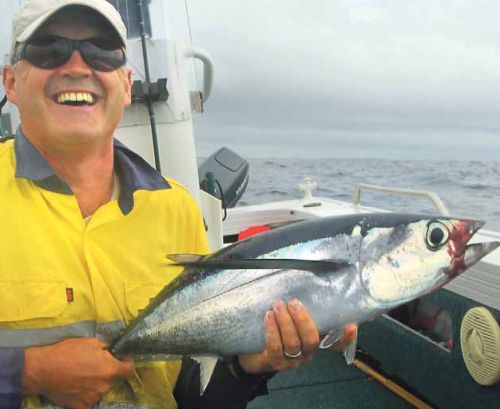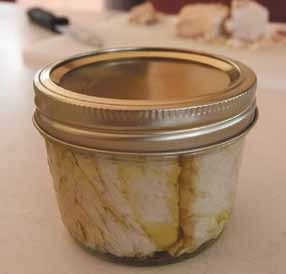 Presented from Issue 103, April 2013
Presented from Issue 103, April 2013
The day dawned overcast, grey and warm with just the hint of a northeaster wafting through. We delayed our arrival at the ramp to allow the post-competition flotilla to depart, launching the boat around 8:30. As we rounded St Helens Point we started to push into a moderate, south-east swell making our way out to the 100 metre line, the point we would start trawling. After dropping back a green and yellow skirt and a Mackbait on two old Penn 330s loaded with 15kg fireline, a third rod was a 6kg spinning outfit with a green and yellow feather jig set well back on the port side. With this spread we proceeded to trawl towards the shelf.
 |
| Cook it outside |
The action was a bit slow until we hit the shelf with only two small, striped tuna hitting the skirts on the way. Things started to happen as the drop off appeared on the sounder. Schools of albacore could easily be seen feeding in the slicks and wind lanes, their sickle-like fins cutting the surface as they fed on krill. As we passed through the closest school first one, then both Penn reels growled in protest as fish hit the lures running closest to the boat, their ratchets continued to buzz as the hooked fish sounded. I kept the boat in gear trawling forward to give the 6kg spinning outfit set further back a chance to get into the school. Within a few seconds that rod also loaded up and the boat was knocked out of gear.
I grabbed the spin rod first, holding on as the 6kg braid melted off the reel at an alarming rate. I resisted the temptation to increase the drag knowing it was pre-set for 3kg and with that amount of line in the water it should eventually take its toll. Craig made short work of a 3kg albacore on one of the Penn outfits, slipping it from the net to the kill tank before grabbing the last rod with fish still attached. Things slowly started to go in my favour as the fish’s first long run slowed to a stop and I was able to gradually win some line back but it still took some time to see colour on the fish as it started circling under the boat. With a few false starts I was able to slip the gaff into an Albacore around the 6kg mark, a heck of a lot of fun on lighter gear. The next few passes produced small fish between two and three kilograms landing in the kill tank to bleed out, a perfect size for the pot. Larger fish could be seen feeding in places but were being beaten to the punch by the smaller fish.
The conditions continued to improve with the wind dropping out almost entirely and the overcast sky staying heavy and dark with the odd shower of rain to encourage the fish to stay on the surface to feed. With plenty of fish in the boat we changed tactics. After positioning the boat up drift from a likely looking school I started casting a soft plastic back into the action. Initially the jig head may have been a bit light as the fish closer to the boat tended to stay down a bit deeper, so after a few fruitless casts I changed to a much heavier one. The change met instant success with the soft plastic being taken on the sink by a small albacore. The fish was boated easily and the soft plastic returned to the fray. For a while things got quite hectic with bent rods and smiles all round. Every now and again we had to reposition the boat to keep in contact with the school as we drifted with the breeze and current, an easy job with the fish on the surface.
By 2pm the north-east breeze returned causing the cloud cover to break up and the bright sun to shine through. Very quickly, fish on the surface became hard to find. With 16 Albacore in the cooler we decided to call it a day. The day had proved to be the best sight fishing for tuna I have ever encountered on the east coast of Tasmania, a day to remember and fire the enthusiasm for future trips. We made good time on the way back to the ramp with the long flat hull of my old Territory river boat making the most of the calm conditions.
Great to eat fresh
Albacore tuna are a fantastic eating fish with a good amount of oil in their flesh, they are an easy fish to cook and very versatile. The trouble is they are only really an option to catch for about three months a year at which time on a good day, you can fill the boat. However once the boat is full, what do you do with them? You stuff yourself with them for a couple of weeks, give them away to friends and family, freeze them and end up avoiding the frozen stuff because it tastes nowhere near as good as the fresh.
 |
| Pick the small fish |
 |
| Cook it slowly right through and it will pull apart easily |
Preserve — don’t freeze them
That’s where preserving comes in. Being a Home Dad these days I do most of the shopping and we eat a lot of small cans of tuna a week. At over $2 a can they add up really fast. Preserving your own is quite easy and it tastes better than the bought stuff and will last for a year in the cupboard.
First I select the smallest fish for preserving as it is easier to fillet the larger fish for the table. Cut the tails and heads off and remove the guts with the head. Don’t worry about the fins, scales etc they will come off quite easily later on. Place the fish in a large pot such as a crayfish cooker and cover with water. The water should be as salty as the sea eg. 35 grams of salt per litre.
DO THIS OUTSIDE !!!! Simmering tuna will stink the house out. Place the pot on a heat source and bring to the boil, then turn it down to a low simmer. If the fish is boiled too vigorously it may break up and you will have one hell of a mess. Depending on the size of the fish it should take between 45 min to 1.5 hours to cook through.
Once the tuna has cooled I clean up the fillets using just a fork. The fish should fall into four parts exposing the bones and bloodlines. Using your hands rub off the skin, scales and remove most of the bones. With the help of the fork it is quite easy to remove the bloodlines and any remaining small bones. You can be as finicky as you like here removing all the small blood vessels ending up with clean white meat if you like. It can be easier to do two passes on the fillets, removing the worst of it while your hands are covered in skin and scales, then a second go while packing the jars.
I use wide mouth Ball Mason jars purchased from ozfarmer.com. They have a large range and the prices are good. These jars have screw top lids and are a tempered glass meant for preserving. The lids are in two parts with a reusable threaded ring and a flat, disposable seal plate. The jars with full lid sets cost about $20-30 a dozen depending on the size. Replacement lid seals are $2 a dozen.The jars have to be washed and sterilised just before you use them. I put mine on oven trays after washing and put them in the oven on 150C for 15 minutes.
Another option is to use Fowlers Vacola jars, number 14 (350ml) or number 20 (600ml) both take size 3 lids, rings and seals. The number 20’s shape isn’t ideal but will do for a first go,are very easily found and will save a few dollars. Fowlers jars have been kicking around for generations and I would be surprised if somebody within your family didn’t have a couple of boxes of them under the house. Garage sales can also be a good place to look. New stainless lids, rubber rings and clips are available from most supermarkets.
 |
 |
 |
| Tasmanians don’t seem to take on preserving their fish.
However with great catchesof tuna over autumn |
Packing the jars is up to you, either flake the meat and pack it in or you can cut the small triangular fillets to the depth of the jar and pack them in end on with four pieces producing a neat fit. To this I like to add some of my home grown Serrano chillies just to spice things up a bit. But at this stage the world is you oyster. Leave the tuna unflavoured or add anything you like to flavour the meat. A good start is to think about what flavours of tuna are on offer at the supermarket and add your own twist. To finish off, just cover the tuna with good quality olive oil, you shouldn’t need too much if the tuna is well packed. DON’T OVERFILL THE JARS. The Ball Masons have a line just below the thread, don’t fill past this line. With the Vacola jars it is 1cm clearance from the lid. The sound of the bottom blowing out of your new tempered glass jars is not a pleasant one.
Once the jars are filled, thoroughly clean the rim to ensure a good seal, taking care to do this properly otherwise you will have wasted your time. Place the lids on ensuring that the seals on the lids are clean and dry. Screw them down nice and tight and stack them either in a Fowlers Vacola preserver or a large pot on the stove. Use the same pot you cooked the tuna in when it has been cleaned, fill with cold fresh water so the jars on top are covered by at least 2cm. Slowly bring the pot to the point of boiling 45min or so,then turn it off and leave it to cool down. Remove the jars and check the seals, the centre of the lids on the Ball Mason jars should be hard down and won’t click when pressed. The Vacola jars when cold should also be sucked down and won’t need the clips to hold them on. Just label them with name and date and stack them in a dark, cool, dry place for up to 1 year.
SBT and Yellow Fin are also fantastic for preserving, you may need to cut them up a bit before cooking or get a very big pot! With a little bit of effort you can easily spread the abundance of the autumn tuna run over the whole year. I get a lot of satisfaction out of making the most out of my catch and it puts a smile on my face every time I go to the cupboard for another jar of double burn chilli tuna.
Simon Hedditch




